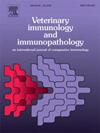Investigation of the relationship between serum endocan level and interleukin-6, procalcitonin, e-selectin in calves with diarrhea, according to the etiological factor
IF 1.4
3区 农林科学
Q4 IMMUNOLOGY
引用次数: 0
Abstract
This study aimed to investigate the association between endothelial damage and inflammatory biomarkers interleukin-6 (IL-6) and procalcitonin (PCT) by evaluating the endothelial markers endocan and E-selectin in cases of calf diarrhea. The study population comprised 49 calves (42 with diarrhea and 7 healthy controls). Blood samples were collected from the diarrheic calves on the 7th and 10th days following diagnosis. Treatment was initiated after the first round of blood sampling. In within-group comparisons, the initial measurements revealed significantly elevated levels of endocan and PCT in the E. coli group compared to the measurements taken on the 7th and 10th days. In between-group comparisons, significant differences were observed between the E. coli and control, rotavirus and control, and C. parvum and control groups. The infected groups exhibited markedly higher levels of endocan on days 1, 7, and 10, and elevated IL-6 levels on day 1. Additionally, E-selectin levels were significantly elevated in the infected groups on day 1, with statistically significant differences noted between the E. coli and control groups, as well as the C. parvum and control groups. PCT level was higher in the infected groups on day 1, but there was a significant difference between E. coli and Control, Rotavirus and Control groups. In conclusion, inflammation and endothelial damage were determined in calves infected with E. coli, Rotavirus, and C. parvum. There was also a positive correlation between inflammation and endothelial damage. According to the data obtained, it was concluded that endocan and E-selectin may be useful biomarkers in determining endothelial damage in calves with diarrhea.
犊牛腹泻血清内啡肽水平与白细胞介素-6、降钙素原、e-选择素的关系及病因分析
本研究旨在通过评估犊牛腹泻中内皮标志物内啡肽和e -选择素,探讨内皮损伤与炎症生物标志物白介素-6 (IL-6)和降钙素原(PCT)之间的关系。研究人群包括49头小牛(42头腹泻,7头健康对照)。于诊断后第7天和第10天对腹泻犊牛采血。在第一轮血液采样后开始治疗。在组内比较中,最初的测量结果显示,与第7天和第10天的测量结果相比,大肠杆菌组的内啡肽和PCT水平显著升高。在组间比较中,大肠杆菌组与对照组、轮状病毒组与对照组、小芽胞杆菌组与对照组之间存在显著差异。感染组在第1、7和10天内啡肽水平明显升高,第1天IL-6水平升高。此外,感染组的e -选择素水平在第1天显著升高,在大肠杆菌组和对照组之间,以及在小孢子虫组和对照组之间都有统计学上的显著差异。感染组在第1天PCT水平较高,但大肠杆菌组与对照组、轮状病毒组与对照组之间存在显著差异。综上所述,犊牛感染大肠杆菌、轮状病毒和细小梭状病毒可引起炎症和内皮损伤。炎症和内皮损伤之间也存在正相关。根据获得的数据,我们得出结论,内啡肽和e -选择素可能是确定犊牛腹泻内皮损伤的有用生物标志物。
本文章由计算机程序翻译,如有差异,请以英文原文为准。
求助全文
约1分钟内获得全文
求助全文
来源期刊
CiteScore
3.40
自引率
5.60%
发文量
79
审稿时长
70 days
期刊介绍:
The journal reports basic, comparative and clinical immunology as they pertain to the animal species designated here: livestock, poultry, and fish species that are major food animals and companion animals such as cats, dogs, horses and camels, and wildlife species that act as reservoirs for food, companion or human infectious diseases, or as models for human disease.
Rodent models of infectious diseases that are of importance in the animal species indicated above,when the disease requires a level of containment that is not readily available for larger animal experimentation (ABSL3), will be considered. Papers on rabbits, lizards, guinea pigs, badgers, armadillos, elephants, antelope, and buffalo will be reviewed if the research advances our fundamental understanding of immunology, or if they act as a reservoir of infectious disease for the primary animal species designated above, or for humans. Manuscripts employing other species will be reviewed if justified as fitting into the categories above.
The following topics are appropriate: biology of cells and mechanisms of the immune system, immunochemistry, immunodeficiencies, immunodiagnosis, immunogenetics, immunopathology, immunology of infectious disease and tumors, immunoprophylaxis including vaccine development and delivery, immunological aspects of pregnancy including passive immunity, autoimmuity, neuroimmunology, and transplanatation immunology. Manuscripts that describe new genes and development of tools such as monoclonal antibodies are also of interest when part of a larger biological study. Studies employing extracts or constituents (plant extracts, feed additives or microbiome) must be sufficiently defined to be reproduced in other laboratories and also provide evidence for possible mechanisms and not simply show an effect on the immune system.

 求助内容:
求助内容: 应助结果提醒方式:
应助结果提醒方式:


